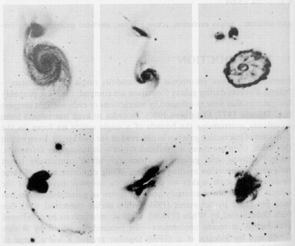 |
Annu. Rev. Astron. Astrophys. 1992. 30:
705-742
Copyright © 1992 by Annual Reviews. All
rights reserved |


1. INTRODUCTION
Interacting galaxies encompass a tremendous
range of phenomena - indeed, if events during galaxy formation are
counted, there are probably few galaxies which were not shaped by
interactions or even outright mergers (e.g.
Toomre 1977;
Efstathiou 1990). In order to
keep our subject from completely overrunning the
bounds of a single article, we focus on the dynamics of interacting
galaxies as observed in our own epoch. Even within this focus, there
are many interrelated topics - including star formation, nuclear
activity, and galactic morphology - which continually tempt reviewers to
depart on inviting tangents. While exploring some of these byways, this
article makes no pretense at a complete coverage of the subject. A
more observationally oriented review of galactic collisions has been
presented by Schweizer (1986),
while earlier numerical work has been summarized by
White (1983b). Galactic
interactions have featured prominently in recent conferences - the
proceedings edited by Wielen
(1990) and by
Sulentic et al. (1990)
together present a wider range of
viewpoints on this subject than we could hope to encompass here. It
is fortunate that excellent reviews of some related topics have
recently appeared. In particular, the reader is referred to
Sellwood (1987) for simulation
techniques, to
Soifer et al. (1987) for
infrared-luminous galaxies, to
Kormendy & Djorgovski (1989) and to
de Zeeuw & Franx (1991)
respectively for the observations and dynamics of elliptical galaxies,
and to Osterbrock (1991) for the
observational status of active galaxies.
Figure 1 presents a few well-known interacting
systems, arranged roughly in order of increasing violence.
M 51's dramatic spiral is
very likely of tidal origin, but how secure would this inference be
without the other signs of tidal damage to both galaxies? Next, we
see gas being transferred from
NCG 3808 to its smaller, spindle-like
companion, where it may eventually form a polar ring. The
``Cartwheel'', on the other hand, is evidently the
result of a direct
hit by one of this galaxy's two small companions.
NGC 4038 /
9, the
``Antennae'', originated in a close encounter of two
comparable disk
galaxies; several 108 yr later extensive tidal tails have
developed and the galaxies have apparently returned for a second
passage. Two intertwined disk galaxies evidently make up
NCG 520,
which was once classified as a single irregular galaxy; CO
observations indicate the presence of a substantial amount of
molecular gas coincident with the dust lane crossing the face of this
object. Finally,
NGC 7252 is a merger remnant ~ 109 yr
old; it exhibits a relaxed body with a de Vaucouleurs' luminosity
profile, a messy, irregular envelope, and a pair of extended tidal
tails as a legacy of the two disk systems destroyed in its making.
The outline of this review is as follows. Numerical methods for
modeling galactic interactions are discussed in
Section 2. Next,
Section 3 describes the signatures written on
interacting galaxies by tidal forces. Events which add mass to a galaxy
are the focus of Section 4, and
major mergers between systems of comparable mass are discussed in
Section 5. The many forms of activity
triggered or induced by galactic interactions are the subject of
Section 6. Finally,
Section 7 discusses these
galaxies' return to normality and related cosmological issues, and
Section 8 lists some outstanding questions.


